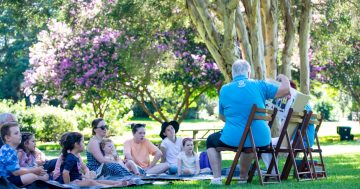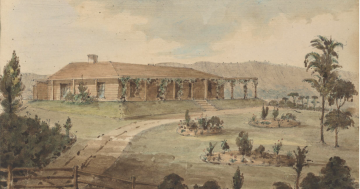
Dr Francis Crossle (front row, second from right) pictured with the Bulli Hospital Board in about 1918. From the collections of Wollongong City Libraries and the Illawarra Historical Society P03/P03496.
Park Road Bulli might seem an unlikely place for a sex scandal, but a doozy erupted down there in the late 1920s.
The highly cultured Dr Francis Clement Crossle – from a distinguished Northern Irish republican family – set up practice in Bulli in 1917, some 15 years before he moved to Sydney to become a Macquarie Street gynaecologist.
Crossle arrived in Bulli (after a no doubt unpleasant stint in Wilcannia) in company with a “Mrs Crossle”, who actually turned out to be the unmarried “Betty Blake” of Galway – an attractive woman who once had her portrait painted by the celebrated Irish artist William Orpin.
No-one twigged that Betty was not legally married until Crossle journeyed back to his birthplace leaving Betty alone with Crossle’s servants in the then lovely wisteria-verandahed residence in Park Road – today the site of a red brick block of flats but with a renovated version of Crossle’s doctor’s surgery still functioning next door.
Being a very cultured man, Dr Crossle became a close friend of the famous Australian artist Norman Lindsay and the Bulli house was said to have its walls cluttered with paintings of naked women by Lindsay.
Indeed, whenever Norman Lindsay felt ill he would take the train from Springwood down to Bulli to recuperate at Crossle’s home located just metres from Bulli Railway Station.
Nonetheless, Crossle is said to have always sent his chauffeur to the station to pick up Lindsay who would then be driven the long way through Woonona to make the journey worthwhile.
When Norman Lindsay was well enough he and Crossle would decamp to Batemans Bay to go fishing.
But that was before the multitalented Richard Pennington entered the scene.

Dr Francis Crossle. Photo: Supplied.
Pennington – a librarian, author, diarist, scholar, and all-round man of letters – was born in 1904 in Rugby, England, where his father was an architectural surveyor, and, of course, was educated at the famous rugby school, winning the English Prize at the age of 16.
From there he went to the University of Birmingham, graduating in 1924 with honours. But in May 1926, Pennington turned up in Sydney as the Australasian literary secretary for an international English educational publisher.
In this role he soon acquired a wide circle of cultured friends and acquaintances – among them the solicitor R Innes Kay (the poet Christopher Brennan’s literary executor); Richard Windeyer KC; A R Radcliffe-Brown, the foundation Professor of Anthropology at Sydney University; the future head of the Public Library of NSW John Metcalfe, whose parties were reputedly legendary; the wonderful Australian artist Thea Proctor; H M Green, the University of Sydney librarian and author of the 1961 A History of Australian Literature and the accountant J A L Gunn, who was to become Australia’s foremost authority on taxation law.
Gunn’s wife described Pennington as a “fine scholar” who opened “many magic casements for us”.
With his father’s interest in architecture, Pennington also led the remarkably successful fight to save the old Berrima Gaol from demolition but he took time to visit Bulli while Dr Crossle was overseas and “Mrs Crossle (aka Betty Blake) apparently found Richard Pennington even more charming than Mrs Gunn”.
One of Crossle’s servants, however, wrote to Crossle in Ireland about what was going on back home and Crossle immediately booked a sea voyage to get back to Bulli.

Artist Norman Lindsay’s bookplate for Dr Francis Crossle. Photo: Supplied.
But on that voyage the good doctor fell in love with a married Belgian woman named Giselle Roth (nee Bluntschili) – the mother of three girls, all under the age of nine.
A subsequent highly publicised and exceedingly lengthy and bitter divorce and custody case over Giselle’s children ensued.
With the divorce achieved and Crossle able to marry Giselle, the court played hard ball and made it exceedingly difficult for the mother to continue to see her three daughters.
Dr Crossle went on to have two children with his wife Giselle – one of whom married a Tasmanian who later became president of the Senate in 1974.
Despite Dr Crossle’s Macquarie Street practice in Sydney taking up much of his time, he still retained his association with the South Coast and was a regular visitor to Austinmer until his death in 1947.
In 1990, in a lovely house perched above Little Austinmer Beach, I interviewed the aged but still very switched-on and fascinating Giselle Crossle prior to her death the following year.
But my great regret is not ever seeing the lovely wisteria-covered verandah of the Crossle house in Park Road Bulli, of which I have been unable to find a single photo, and never having the opportunity to see Crossle’s art collection which reputedly once included a rare Norman Lindsay painting of Bulli Beach.










